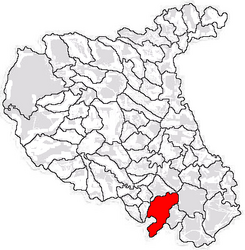Sihlea | |
|---|---|
 Location in Vrancea County | |
| Coordinates: 45°30′N 27°7′E / 45.500°N 27.117°E | |
| Country | Romania |
| County | Vrancea |
| Government | |
| • Mayor (2020–2024) | Radu Modreanu (Ind.) |
| Area | 88.24 km2 (34.07 sq mi) |
| Elevation | 105 m (344 ft) |
| Population (2021-12-01)[1] | 4,989 |
| • Density | 57/km2 (150/sq mi) |
| Time zone | EET/EEST (UTC+2/+3) |
| Postal code | 627300 |
| Vehicle reg. | VN |
| Website | www |
Sihlea is a commune located in Vrancea County, Romania. It is composed of four villages: Bogza, Căiata, Sihlea, and Voetin.
The commune is located in the southern extremity of the county, 28 km (17 mi) from the county capital, Focșani. Sihlea is situated on the border with Buzău County, only 17 km (11 mi) from Râmnicu Sărat. It lies on the left bank of the river Coțatcu and on both banks of its tributary, the Slimnic.
Sihlea is crossed by the county road DJ202E, which connects it to the west with Obrejița (where it intersects with national road DN2) and further to Tâmboești, and to the south to Râmnicelu. In the north, it is also crossed by the national road DN2N, which connects it to the east with Tătăranu (where it ends in DN23A) and to the west with Dumbrăveni (where it intersects with the same DN2), Bordești, Dumitrești, Chiojdeni, and Jitia. The partly built A7 motorway, which starts in Ploiești in the direction of Buzău, will enter Vrancea County in Sihlia, continuing north towards Focșani and ending in Siret.[2]
Train stations in Voetin and Sihlea villages serve the CFR Main Line 500, which connects Bucharest with the Ukrainian border near Chernivtsi.
According to the 2011 census, the commune had a population of 5,039, of which 90% were ethnic Romanians and 5.9% were Roma.
Natives
[edit]- Gheorghe Buzatu (1939–2013), historian and politician
References
[edit]- ^ "Populaţia rezidentă după grupa de vârstă, pe județe și municipii, orașe, comune, la 1 decembrie 2021" (XLS). National Institute of Statistics.
- ^ Borcea, Ciprian (May 11, 2022). "Concurență mare pentru construirea Autostrăzii A7. Nu mai puțin de 28 de firme s-au înscris la licitație". Adevărul (in Romanian). Retrieved October 22, 2022.


Well, that’s interesting to know that Psilotum nudum are known as whisk ferns. Psilotum nudum is the commoner species of the two. While the P. flaccidum is a rare species and is found in the tropical islands. Both the species are usually epiphytic in habit and grow upon tree ferns. These species may also be terrestrial and grow in humus or in the crevices of the rocks.
View the detailed Guide of Psilotum nudum: Detailed Study Of Psilotum Nudum (Whisk Fern), Classification, Anatomy, Reproduction